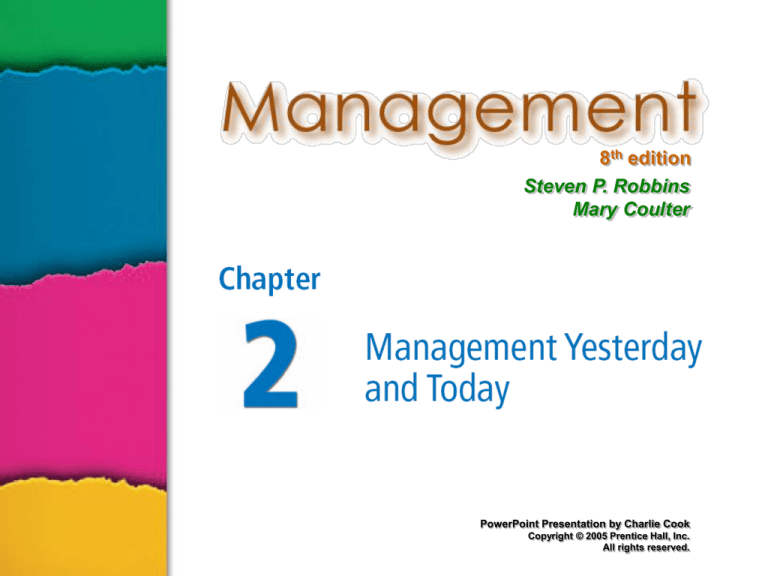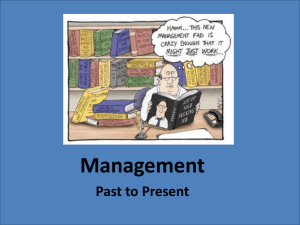
8th edition
Steven P. Robbins
Mary Coulter
PowerPoint Presentation by Charlie Cook
Copyright © 2005 Prentice Hall, Inc.
All rights reserved.
LEARNING OUTLINE
Follow this Learning Outline as you read and study this chapter.
o Historical Background of Management
• Explain why studying management history is important.
• Describe some early evidences of management practice.
• Discuss why division of labor and the Industrial
Revolution are important to the study of management.
• List six management approaches.
• Scientific Management
• Define scientific management.
• Describe the important contributions made by Fredrick W.
Taylor and Frank and Lillian Gilbreth.
• Explain how today’s managers use scientific
management.
Copyright © 2005 Prentice Hall, Inc. All rights reserved.
2–2
L E A R N I N G O U T L I N E (cont’d)
Follow this Learning Outline as you read and study this chapter.
oGeneral Administrative Theorists
• Tell what the general administrative theorists brought to
the study of management.
• Describe how Fayol viewed the practice of management
• Explain why Fayol developed his principles of
management.
• Discuss Fayol’s 14 management principles.
• Describe Max Weber’s contribution to the general
administrative theory of management,
• Define the characteristics of a bureaucracy
• Explain how today’s managers use general administrative
theory.
Copyright © 2005 Prentice Hall, Inc. All rights reserved.
2–3
L E A R N I N G O U T L I N E (cont’d)
Follow this Learning Outline as you read and study this chapter.
oQuantitative Approach to Management
• Define the quantitative approach and how it evolved.
• Explain what the quantitative approach has contributed to
the field of management.
• Discuss how today’s managers may not be comfortable
with the quantitative approach.
•Toward Under Organizational Behavior
• Define organizational behavior.
• Describe the contributions of the early advocates of OB.
• Describe the design of the Hawthorne Studies.
• Explain the contributions of the Hawthorne Studies to the
field of management.
Copyright © 2005 Prentice Hall, Inc. All rights reserved.
2–4
L E A R N I N G O U T L I N E (cont’d)
Follow this Learning Outline as you read and study this chapter.
oToward Understanding Organizational Behavior
(cont’d)
• Discuss the criticisms of the Hawthorne Studies.
• Discuss how today’s managers use the behavioral
approach.
oThe Systems Approach
• Define a system.
• Contrast closed systems and open systems.
• Describe an organization using the systems approach.
• Discuss how the systems approach is appropriate for
understanding management.
Copyright © 2005 Prentice Hall, Inc. All rights reserved.
2–5
L E A R N I N G O U T L I N E (cont’d)
Follow this Learning Outline as you read and study this chapter.
oThe Contingency Approach
• Define the contingency approach
• Explain how the contingency approach differs from the
early theories of management
• Discuss the popular contingency variables.
• Discuss how the contingency approach is appropriate for
studying management
oCurrent Issues and Trends
• Explain why we need to look at the current trends and
issues facing managers.
• Define workforce diversity, entrepreneurship, e-business,
learning organization, knowledge management, and
quality management.
Copyright © 2005 Prentice Hall, Inc. All rights reserved.
2–6
Historical Background of Management
• Ancient Management
Egypt (pyramids) and China (Great Wall)
Venetians (floating warship assembly lines)
• Adam Smith
Published “The Wealth of Nations” in 1776
Advocated
the division of labor (job specialization) to
increase the productivity of workers
• Industrial Revolution
Substituted machine power for human labor
Created large organizations in need of management
Copyright © 2005 Prentice Hall, Inc. All rights reserved.
2–7
Major Approaches to Management
• Scientific Management
• General Administrative Theory
• Quantitative Management
• Organizational Behavior
• Systems Approach
• Contingency Approach
Copyright © 2005 Prentice Hall, Inc. All rights reserved.
2–8
Scientific Management
• Fredrick Winslow Taylor
The “father” of scientific management
Published Principles of Scientific Management (1911)
The
theory of scientific management:
– Using scientific methods to define the “one best way” for a
job to be done
• Putting the right person on the job with the correct tools
and equipment
• Having a standardized method of doing the job
• Providing an economic incentive to the worker
Copyright © 2005 Prentice Hall, Inc. All rights reserved.
2–9
Scientific Management (cont’d)
• Frank and Lillian Gilbreth
Focused on increasing worker productivity through
the reduction of wasted motion
Developed the microchronometer to time worker
motions and optimize performance.
• How Do Today’s Managers Use Scientific
Management?
Use time and motion studies to increase productivity
Hire the best qualified employees
Design incentive systems based on output
Copyright © 2005 Prentice Hall, Inc. All rights reserved.
2–10
General Administrative Theorists
• Henri Fayol
Believed that the practice of management was distinct
from other organizational functions
Developed fourteen principles of management that
applied to all organizational situations
• Max Weber
Developed a theory of authority based on an ideal
type of organization (bureaucracy)
Emphasized
rationality, predictability, impersonality,
technical competence, and authoritarianism.
Copyright © 2005 Prentice Hall, Inc. All rights reserved.
2–11
Quantitative Approach to Management
• Quantitative Approach
Also called operations research or management
science
Evolved from mathematical and statistical methods
developed to solve WWII military logistics and quality
control problems
Focuses on improving managerial decision making by
applying:
Statistics,
optimization models, information models, and
computer simulations
Copyright © 2005 Prentice Hall, Inc. All rights reserved.
2–12






